简介
Apache Hudi(Hadoop Upserts Delete and Incremental)是下一代流数据湖平台。Apache Hudi将核心仓库和数据库功能直接引入数据湖。Hudi提供了表、事务、高效的upserts/delete、高级索引、流摄取服务、数据集群/压缩优化和并发,同时保持数据的开源文件格式。
Apache Hudi不仅非常适合于流工作负载,而且还允许创建高效的增量批处理管道。
Apache Hudi可以轻松地在任何云存储平台上使用。Hudi的高级性能优化,使分析工作负载更快的任何流行的查询引擎,包括Apache Spark、Flink、Presto、Trino、Hive等。
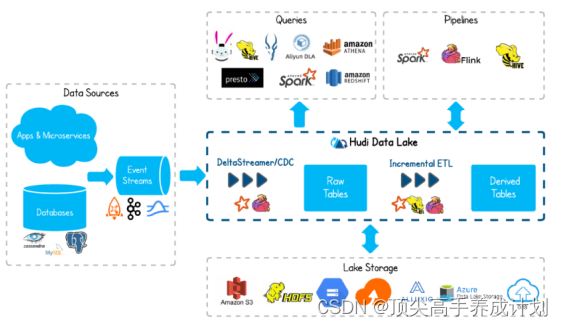
特性
- 可插拔索引机制支持快速Upsert/Delete。
- 支持增量拉取表变更以进行处理。
- 支持事务提交及回滚,并发控制。
- 支持Spark、Presto、Trino、Hive、Flink等引擎的SQL读写。
- 自动管理小文件,数据聚簇,压缩,清理。
- 流式摄入,内置CDC源和工具。
- 内置可扩展存储访问的元数据跟踪。
- 向后兼容的方式实现表结构变更的支持。
使用场景
- 减少碎片化工具的使用。
- CDC 增量导入 RDBMS 数据。
- 限制小文件的大小和数量。
- 相对于秒级存储(Druid, OpenTSDB),节省资源。
- 提供分钟级别时效性,支撑更高效的查询。
- Hudi作为lib,非常轻量。
- 区分arrivetime和event time处理延迟数据。
- 更短的调度interval减少端到端延迟(小时 -> 分钟) => Incremental Processing。
- 替代部分Kafka的场景,数据导出到在线服务存储 e.g. ES。
编译安装
Hadoop
3.1.3
Hive
3.1.2
Flink
1.13.6,scala-2.12
Spark
3.2.2,scala-2.12
下载地址
链接:https://pan.baidu.com/s/1X13Bo5LwrFC4NIpzPF73tQ
提取码:tk32
--来自百度网盘超级会员V5的分享
编译源码
安装Maven
上传apache-maven-3.6.1-bin.tar.gz到目录,并解压更名
tar -zxvf apache-maven-3.6.1-bin.tar.gz -C ../module/
添加环境变量到/etc/profile中
#MAVEN_HOME
export MAVEN_HOME=/home/bigdata/module/apache-maven-3.6.1
PATH=$PATH:$MAVEN_HOME/bin
export PATH
测试安装结果
source /etc/profile
mvn -v
修改为阿里镜像
修改setting.xml,指定为阿里仓库地址
vi /home/bigdata/module/apache-maven-3.6.1/conf/settings.xml
<!-- 添加阿里云镜像-->
<mirror>
<id>nexus-aliyun</id>
<mirrorOf>central</mirrorOf>
<name>Nexus aliyun</name>
<url>http://maven.aliyun.com/nexus/content/groups/public</url>
</mirror>
编译Hudi
将hudi-0.12.0.src.tgz上传到/opt/software,并解压
tar -zxvf hudi-0.12.0.src.tgz -C ../module/
解决和Hadoop版本冲突问题

修改依赖的组件版本(修改pom.xml)
<!--<hadoop.version>2.10.1</hadoop.version> !-->
<hadoop.version>3.1.3</hadoop.version>
<hive.groupid>org.apache.hive</hive.groupid>
<!--<hive.version>2.3.1</hive.version> !-->
<hive.version>3.1.2</hive.version>
修改源码兼容hadoop3
Hudi默认依赖的hadoop2,要兼容hadoop3,除了修改版本,还需要修改如下代码:
修改第110行,原先只有一个参数,添加第二个参数null:

否则会因为hadoop2.x和3.x版本兼容问题,报错如下:

手动安装Kafka依赖
有几个kafka的依赖需要手动安装,否则编译报错如下:

下载jar包
通过网址下载:http://packages.confluent.io/archive/5.3/confluent-5.3.4-2.12.zip
解压后找到以下jar包,上传服务器
- common-config-5.3.4.jar
- common-utils-5.3.4.jar
- kafka-avro-serializer-5.3.4.jar
- kafka-schema-registry-client-5.3.4.jar
install到maven本地仓库
mvn install:install-file -DgroupId=io.confluent -DartifactId=common-config -Dversion=5.3.4 -Dpackaging=jar -Dfile=./common-config-5.3.4.jar
mvn install:install-file -DgroupId=io.confluent -DartifactId=common-utils -Dversion=5.3.4 -Dpackaging=jar -Dfile=./common-utils-5.3.4.jar
mvn install:install-file -DgroupId=io.confluent -DartifactId=kafka-avro-serializer -Dversion=5.3.4 -Dpackaging=jar -Dfile=./kafka-avro-serializer-5.3.4.jar
mvn install:install-file -DgroupId=io.confluent -DartifactId=kafka-schema-registry-client -Dversion=5.3.4 -Dpackaging=jar -Dfile=./kafka-schema-registry-client-5.3.4.jar
解决spark模块依赖冲突
修改了Hive版本为3.1.2,其携带的jetty是0.9.3,hudi本身用的0.9.4,存在依赖冲突。
修改hudi-spark-bundle的pom文件,排除低版本jetty,添加hudi指定版本的jetty:
vi packaging/hudi-spark-bundle/pom.xml
在382行的位置,修改如下(红色部分):
<!-- Hive -->
<dependency>
<groupId>${hive.groupid}</groupId>
<artifactId>hive-service</artifactId>
<version>${hive.version}</version>
<scope>${spark.bundle.hive.scope}</scope>
<exclusions>
<exclusion>
<artifactId>guava</artifactId>
<groupId>com.google.guava</groupId>
</exclusion>
<exclusion>
<groupId>org.eclipse.jetty</groupId>
<artifactId>*</artifactId>
</exclusion>
<exclusion>
<groupId>org.pentaho</groupId>
<artifactId>*</artifactId>
</exclusion>
</exclusions>
</dependency>
<dependency>
<groupId>${hive.groupid}</groupId>
<artifactId>hive-service-rpc</artifactId>
<version>${hive.version}</version>
<scope>${spark.bundle.hive.scope}</scope>
</dependency>
<dependency>
<groupId>${hive.groupid}</groupId>
<artifactId>hive-jdbc</artifactId>
<version>${hive.version}</version>
<scope>${spark.bundle.hive.scope}</scope>
<exclusions>
<exclusion>
<groupId>javax.servlet</groupId>
<artifactId>*</artifactId>
</exclusion>
<exclusion>
<groupId>javax.servlet.jsp</groupId>
<artifactId>*</artifactId>
</exclusion>
<exclusion>
<groupId>org.eclipse.jetty</groupId>
<artifactId>*</artifactId>
</exclusion>
</exclusions>
</dependency>
<dependency>
<groupId>${hive.groupid}</groupId>
<artifactId>hive-metastore</artifactId>
<version>${hive.version}</version>
<scope>${spark.bundle.hive.scope}</scope>
<exclusions>
<exclusion>
<groupId>javax.servlet</groupId>
<artifactId>*</artifactId>
</exclusion>
<exclusion>
<groupId>org.datanucleus</groupId>
<artifactId>datanucleus-core</artifactId>
</exclusion>
<exclusion>
<groupId>javax.servlet.jsp</groupId>
<artifactId>*</artifactId>
</exclusion>
<exclusion>
<artifactId>guava</artifactId>
<groupId>com.google.guava</groupId>
</exclusion>
</exclusions>
</dependency>
<dependency>
<groupId>${hive.groupid}</groupId>
<artifactId>hive-common</artifactId>
<version>${hive.version}</version>
<scope>${spark.bundle.hive.scope}</scope>
<exclusions>
<exclusion>
<groupId>org.eclipse.jetty.orbit</groupId>
<artifactId>javax.servlet</artifactId>
</exclusion>
<exclusion>
<groupId>org.eclipse.jetty</groupId>
<artifactId>*</artifactId>
</exclusion>
</exclusions>
</dependency>
<!-- 增加hudi配置版本的jetty -->
<dependency>
<groupId>org.eclipse.jetty</groupId>
<artifactId>jetty-server</artifactId>
<version>${jetty.version}</version>
</dependency>
<dependency>
<groupId>org.eclipse.jetty</groupId>
<artifactId>jetty-util</artifactId>
<version>${jetty.version}</version>
</dependency>
<dependency>
<groupId>org.eclipse.jetty</groupId>
<artifactId>jetty-webapp</artifactId>
<version>${jetty.version}</version>
</dependency>
<dependency>
<groupId>org.eclipse.jetty</groupId>
<artifactId>jetty-http</artifactId>
<version>${jetty.version}</version>
</dependency>
否则在使用spark向hudi表插入数据时,会报错如下:
java.lang.NoSuchMethodError: org.apache.hudi.org.apache.jetty.server.session.SessionHandler.setHttpOnly(Z)V
 修改hudi-utilities-bundle的pom文件,排除低版本jetty,添加hudi指定版本的jetty:
修改hudi-utilities-bundle的pom文件,排除低版本jetty,添加hudi指定版本的jetty:
vi packaging/hudi-utilities-bundle/pom.xml
在405行的位置,修改如下(红色部分):
<!-- Hoodie -->
<dependency>
<groupId>org.apache.hudi</groupId>
<artifactId>hudi-common</artifactId>
<version>${project.version}</version>
<exclusions>
<exclusion>
<groupId>org.eclipse.jetty</groupId>
<artifactId>*</artifactId>
</exclusion>
</exclusions>
</dependency>
<dependency>
<groupId>org.apache.hudi</groupId>
<artifactId>hudi-client-common</artifactId>
<version>${project.version}</version>
<exclusions>
<exclusion>
<groupId>org.eclipse.jetty</groupId>
<artifactId>*</artifactId>
</exclusion>
</exclusions>
</dependency>
<!-- Hive -->
<dependency>
<groupId>${hive.groupid}</groupId>
<artifactId>hive-service</artifactId>
<version>${hive.version}</version>
<scope>${utilities.bundle.hive.scope}</scope>
<exclusions>
<exclusion>
<artifactId>servlet-api</artifactId>
<groupId>javax.servlet</groupId>
</exclusion>
<exclusion>
<artifactId>guava</artifactId>
<groupId>com.google.guava</groupId>
</exclusion>
<exclusion>
<groupId>org.eclipse.jetty</groupId>
<artifactId>*</artifactId>
</exclusion>
<exclusion>
<groupId>org.pentaho</groupId>
<artifactId>*</artifactId>
</exclusion>
</exclusions>
</dependency>
<dependency>
<groupId>${hive.groupid}</groupId>
<artifactId>hive-service-rpc</artifactId>
<version>${hive.version}</version>
<scope>${utilities.bundle.hive.scope}</scope>
</dependency>
<dependency>
<groupId>${hive.groupid}</groupId>
<artifactId>hive-jdbc</artifactId>
<version>${hive.version}</version>
<scope>${utilities.bundle.hive.scope}</scope>
<exclusions>
<exclusion>
<groupId>javax.servlet</groupId>
<artifactId>*</artifactId>
</exclusion>
<exclusion>
<groupId>javax.servlet.jsp</groupId>
<artifactId>*</artifactId>
</exclusion>
<exclusion>
<groupId>org.eclipse.jetty</groupId>
<artifactId>*</artifactId>
</exclusion>
</exclusions>
</dependency>
<dependency>
<groupId>${hive.groupid}</groupId>
<artifactId>hive-metastore</artifactId>
<version>${hive.version}</version>
<scope>${utilities.bundle.hive.scope}</scope>
<exclusions>
<exclusion>
<groupId>javax.servlet</groupId>
<artifactId>*</artifactId>
</exclusion>
<exclusion>
<groupId>org.datanucleus</groupId>
<artifactId>datanucleus-core</artifactId>
</exclusion>
<exclusion>
<groupId>javax.servlet.jsp</groupId>
<artifactId>*</artifactId>
</exclusion>
<exclusion>
<artifactId>guava</artifactId>
<groupId>com.google.guava</groupId>
</exclusion>
</exclusions>
</dependency>
<dependency>
<groupId>${hive.groupid}</groupId>
<artifactId>hive-common</artifactId>
<version>${hive.version}</version>
<scope>${utilities.bundle.hive.scope}</scope>
<exclusions>
<exclusion>
<groupId>org.eclipse.jetty.orbit</groupId>
<artifactId>javax.servlet</artifactId>
</exclusion>
<exclusion>
<groupId>org.eclipse.jetty</groupId>
<artifactId>*</artifactId>
</exclusion>
</exclusions>
</dependency>
<!-- 增加hudi配置版本的jetty -->
<dependency>
<groupId>org.eclipse.jetty</groupId>
<artifactId>jetty-server</artifactId>
<version>${jetty.version}</version>
</dependency>
<dependency>
<groupId>org.eclipse.jetty</groupId>
<artifactId>jetty-util</artifactId>
<version>${jetty.version}</version>
</dependency>
<dependency>
<groupId>org.eclipse.jetty</groupId>
<artifactId>jetty-webapp</artifactId>
<version>${jetty.version}</version>
</dependency>
<dependency>
<groupId>org.eclipse.jetty</groupId>
<artifactId>jetty-http</artifactId>
<version>${jetty.version}</version>
</dependency>
否则在使用DeltaStreamer工具向hudi表插入数据时,也会报Jetty的错误。
执行编译命令
编译加速
vim hudi-0.12.0/pom.xml
<repository>
<id>nexus-aliyun</id>
<name>nexus-aliyun</name>
<url>http://maven.aliyun.com/nexus/content/groups/public/</url>
<releases>
<enabled>true</enabled>
</releases>
<snapshots>
<enabled>false</enabled>
</snapshots>
</repository>
mvn clean package -DskipTests -Dspark3.2 -Dflink1.13 -Dscala-2.12 -Dhadoop.version=3.1.3 -Pflink-bundle-shade-hive3
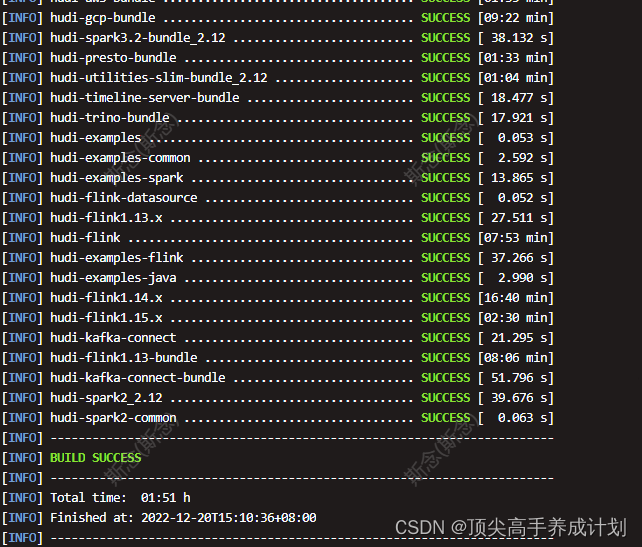
编译好集成的包
cd /home/bigdata/module/hudi-0.12.0/packaging/hudi-spark-bundle/target
需要集成什么就到对应的package的target找到对应的jar包


核心概念
时间轴(TimeLine)
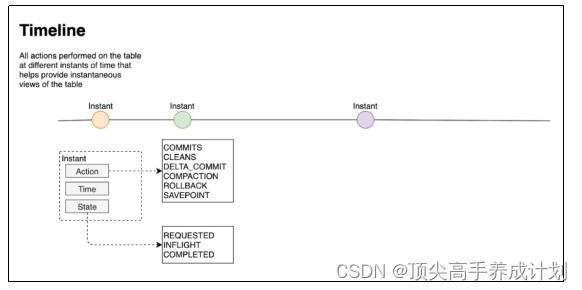
Hudi的核心是维护表上在不同的即时时间(instants)执行的所有操作的时间轴(timeline),这有助于提供表的即时视图,同时还有效地支持按到达顺序检索数据。一个instant由以下三个部分组成:
Instant action****:在表上执行的操作类型
- COMMITS:一次commit表示将一批数据原子性地写入一个表。
- CLEANS:清除表中不再需要的旧版本文件的后台活动。
- DELTA_COMMIT:增量提交指的是将一批数据原子性地写入一个MergeOnRead类型的表,其中部分或所有数据可以写入增量日志。
- COMPACTION:合并Hudi内部差异数据结构的后台活动,例如:将更新操作从基于行的log日志文件合并到列式存储的数据文件。在内部,COMPACTION体现为timeline上的特殊提交。
- ROLLBACK:表示当commit/delta_commit不成功时进行回滚,其会删除在写入过程中产生的部分文件。
- SAVEPOINT:将某些文件组标记为已保存,以便其不会被删除。在发生灾难需要恢复数据的情况下,它有助于将数据集还原到时间轴上的某个点。
Instant time
通常是一个时间戳(例如:20190117010349),它按照动作开始时间的顺序单调增加。State
State
- REQUESTED:表示某个action已经调度,但尚未执行。
- INFLIGHT:表示action当前正在执行。
- COMPLETED:表示timeline上的action已经完成。
两个时间概念
区分两个重要的时间概念:
- Arrival time: 数据到达 Hudi 的时间,commit time。
- Event time: record 中记录的时间。
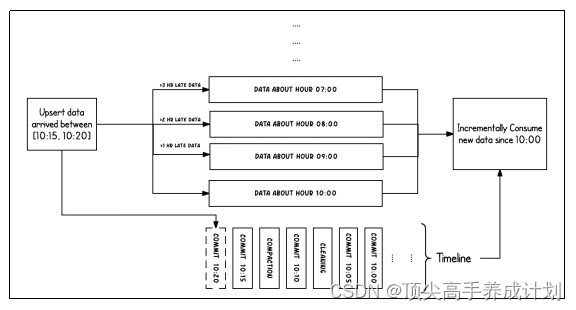
上图中采用时间(小时)作为分区字段,从 10:00 开始陆续产生各种 commits,10:20 来了一条 9:00 的数据,根据event time该数据仍然可以落到 9:00 对应的分区,通过 timeline 直接消费 10:00 (commit time)之后的增量更新(只消费有新 commits 的 group),那么这条延迟的数据仍然可以被消费到。
文件布局(File Layout)
Hudi将一个表映射为如下文件结构

Hudi存储分为两个部分:
(1)元数据:.hoodie目录对应着表的元数据信息,包括表的版本管理(Timeline)、归档目录(存放过时的instant也就是版本),一个instant记录了一次提交(commit)的行为、时间戳和状态,Hudi以时间轴的形式维护了在数据集上执行的所有操作的元数据;
(2)数据:和hive一样,以分区方式存放数据;分区里面存放着Base File(.parquet)和Log File(.log.*);
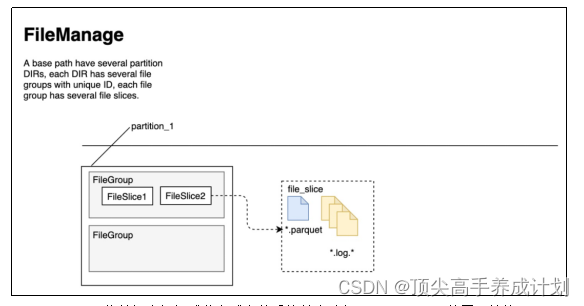
(1)Hudi将数据表组织成分布式文件系统基本路径(basepath)下的目录结构
(2)表被划分为多个分区,这些分区是包含该分区的数据文件的文件夹,非常类似于Hive表
(3)在每个分区中,文件被组织成文件组,由文件ID唯一标识
(4)每个文件组包含几个文件片(FileSlice)
(5)每个文件片包含:
- 一个基本文件(.parquet):在某个commit/compaction即时时间(instant time)生成的(MOR可能没有)
- 多个日志文件(.log.*),这些日志文件包含自生成基本文件以来对基本文件的插入/更新(COW没有)
(6)Hudi采用了多版本并发控制(Multiversion Concurrency Control, MVCC)
- compaction操作:合并日志和基本文件以产生新的文件片
- clean操作:清除不使用的/旧的文件片以回收文件系统上的空间
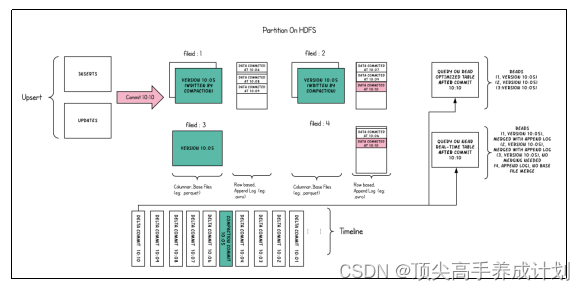
(7)Hudi的base file(parquet 文件)在 footer 的 meta 去记录了 record key 组成的 BloomFilter,用于在 file based index 的实现中实现高效率的 key contains 检测。只有不在 BloomFilter 的 key 才需要扫描整个文件消灭假阳。
(8)Hudi 的 log (avro 文件)是自己编码的,通过积攒数据 buffer 以 LogBlock 为单位写出,每个 LogBlock 包含 magic number、size、content、footer 等信息,用于数据读、校验和过滤。
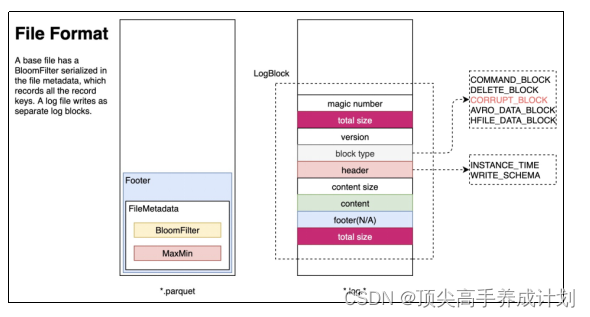
索引(Index)
1)原理
Hudi通过索引机制提供高效的upserts,具体是将给定的hoodie key(record key + partition path)与文件id(文件组)建立唯一映射。这种映射关系,数据第一次写入文件后保持不变,所以,一个 FileGroup 包含了一批 record 的所有版本记录。Index 用于区分消息是 INSERT 还是 UPDATE。
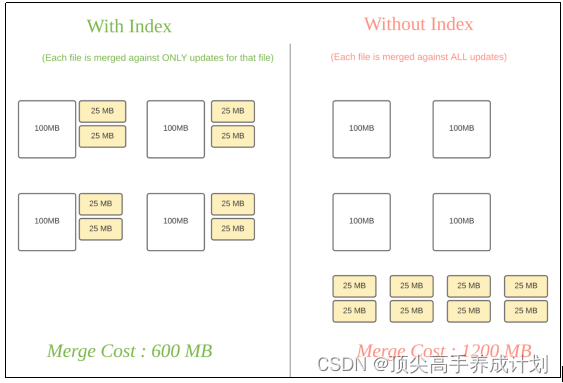
Hudi 为了消除不必要的读写,引入了索引的实现。在有了索引之后,更新的数据可以快速被定位到对应的 File Group。上图为例,白色是基本文件,黄色是更新数据,有了索引机制,可以做到:避免读取不需要的文件、避免更新不必要的文件、无需将更新数据与历史数据做分布式关联,只需要在 File Group 内做合并。
2****)索引选项
I****ndex类型
原理
优点
缺点
Bloom Index
默认配置,使用布隆过滤器来判断记录存在与否,也可选使用record key的范围裁剪需要的文件
效率高,不依赖外部系统,数据和索引保持一致性
因假阳性问题,还需回溯原文件再查找一遍
Simple Index
把update/delete操作的新数据和老数据进行join
实现最简单,无需额外的资源
性能比较差
HBase Index
把index存放在HBase里面。在插入 File Group定位阶段所有task向HBase发送 Batch Get 请求,获取 Record Key 的 Mapping 信息
对于小批次的keys,查询效率高
需要外部的系统,增加了运维压力
Flink State-based Index
HUDI 在 0.8.0 版本中实现的 Flink witer,采用了 Flink 的 state 作为底层的 index 存储,每个 records 在写入之前都会先计算目标 bucket ID。
不同于 BloomFilter Index,避免了每次重复的文件 index 查找
注意:Flink只有一种state based index(和bucket_index),其他index是Spark可选配置。
3)全局索引与非全局索引
全局索引:全局索引在全表的所有分区范围下强制要求键的唯一性,也就是确保对给定的键有且只有一个对应的记录。全局索引提供了更强的保证,但是随着表增大,update/delete 操作损失的性能越高,因此更适用于小表。
非全局索引:默认的索引实现,只能保证数据在分区的唯一性。非全局索引依靠写入器为同一个记录的update/delete提供一致的分区路径,同时大幅提高了效率,更适用于大表。
从index的维护成本和写入性能的角度考虑,维护一个global index的难度更大,对写入性能的影响也更大,所以需要non-global index。
HBase索引本质上是一个全局索引,bloom和simple index都有全局选项:
- hoodie.index.type=GLOBAL_BLOOM
- hoodie.index.type=GLOBAL_SIMPLE
4)索引的选择策略
(1)对事实表的延迟更新
许多公司会在NoSQL数据存储中存放大量的交易数据。例如共享出行的行程表、股票买卖记录的表、和电商的订单表。这些表通常一直在增长,且大部分的更新随机发生在较新的记录上,而对旧记录有着长尾分布型的更新。这通常是源于交易关闭或者数据更正的延迟性。换句话说,大部分更新会发生在最新的几个分区上而小部分会在旧的分区。
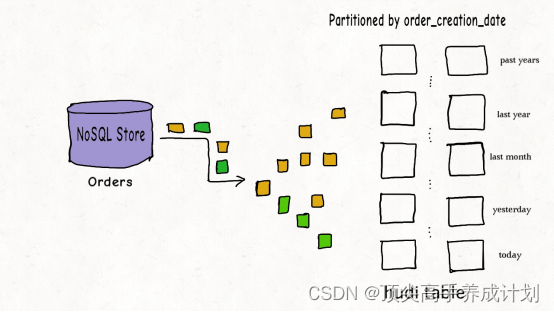
对于这样的作业模式,布隆索引就能表现地很好,因为查询索引可以靠设置得当的布隆过滤器来裁剪很多数据文件。另外,如果生成的键可以以某种顺序排列,参与比较的文件数会进一步通过范围裁剪而减少。Hudi用所有文件的键域来构造区间树,这样能来高效地依据输入的更删记录的键域来排除不匹配的文件。
为了高效地把记录键和布隆过滤器进行比对,即尽量减少过滤器的读取和均衡执行器间的工作量,Hudi缓存了输入记录并使用了自定义分区器和统计规律来解决数据的偏斜。有时,如果布隆过滤器的假阳性率过高,查询会增加数据的打乱操作。Hudi支持动态布隆过滤器(设置hoodie.bloom.index.filter.type=DYNAMIC_V0)。它可以根据文件里存放的记录数量来调整大小从而达到设定的假阳性率。
(2)对事件表的去重
事件流无处不在。从Apache Kafka或其他类似的消息总线发出的事件数通常是事实表大小的10-100倍。事件通常把时间(到达时间、处理时间)作为首类处理对象,比如物联网的事件流、点击流数据、广告曝光数等等。由于这些大部分都是仅追加的数据,插入和更新只存在于最新的几个分区中。由于重复事件可能发生在整个数据管道的任一节点,在存放到数据湖前去重是一个常见的需求。
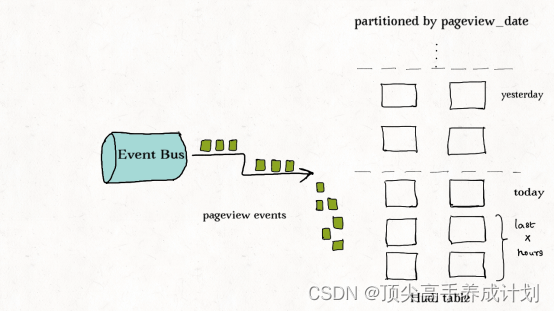
总的来说,低消耗去重是一个非常有挑战的工作。虽然可以用一个键值存储来实现去重(即HBase索引),但索引存储的消耗会随着事件数增长而线性增长以至于变得不可行。事实上,有范围裁剪功能的布隆索引是最佳的解决方案。我们可以利用作为首类处理对象的时间来构造由事件时间戳和事件id(event_ts+event_id)组成的键,这样插入的记录就有了单调增长的键。这会在最新的几个分区里大幅提高裁剪文件的效益。
(3)对维度表的随机更删
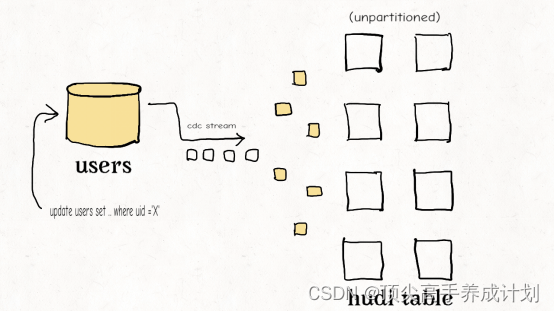
正如之前提到的,如果范围比较不能裁剪许多文件的话,那么布隆索引并不能带来很好的效益。在这样一个随机写入的作业场景下,更新操作通常会触及表里大多数文件从而导致布隆过滤器依据输入的更新对所有文件标明阳性。最终会导致,即使采用了范围比较,也还是检查了所有文件。使用简单索引对此场景更合适,因为它不采用提前的裁剪操作,而是直接和所有文件的所需字段连接。如果额外的运维成本可以接受的话,也可以采用HBase索引,其对这些表能提供更加优越的查询效率。
当使用全局索引时,也可以考虑通过设置hoodie.bloom.index.update.partition.path=true或hoodie.simple.index.update.partition.path=true来处理 的情况;例如对于以所在城市分区的用户表,会有用户迁至另一座城市的情况。这些表也非常适合采用Merge-On-Read表型。
表类型(Table Types)
1)Copy On Write
在COW表中,只有数据文件/基本文件(.parquet),没有增量日志文件(.log.*)。
对每一个新批次写入都将创建相应数据文件的新版本(新的FileSlice),新版本文件包括旧版本文件的记录以及来自传入批次的记录(全量最新)。
假设我们有 3 个文件组,其中包含如下数据文件。

我们进行一批新的写入,在索引后,我们发现这些记录与File group 1 和File group 2 匹配,然后有新的插入,我们将为其创建一个新的文件组(File group 4)。
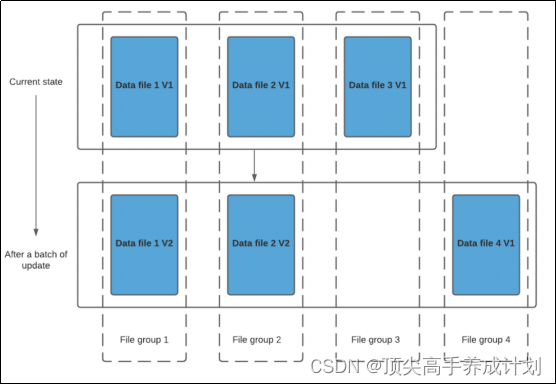
因此data_file1 和 data_file2 都将创建更新的版本,data_file1 V2 是data_file1 V1 的内容与data_file1 中传入批次匹配记录的记录合并。
由于在写入期间进行合并,COW 会产生一些写入延迟。但是COW 的优势在于它的简单性,不需要其他表服务(如压缩),也相对容易调试。
2)****Merge On Read
MOR表中,包含列存的基本文件(.parquet)和行存的增量日志文件(基于行的avro格式,.log.*)。
顾名思义,MOR表的合并成本在读取端。因此在写入期间我们不会合并或创建较新的数据文件版本。标记/索引完成后,对于具有要更新记录的现有数据文件,Hudi 创建增量日志文件并适当命名它们,以便它们都属于一个文件组。
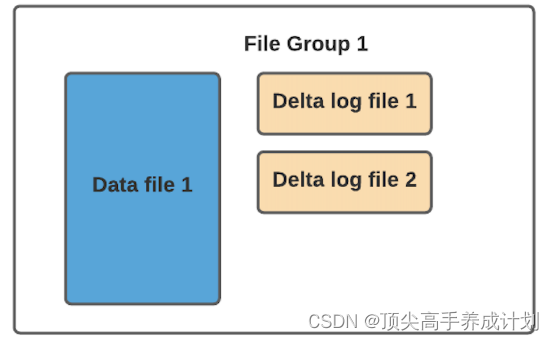
读取端将实时合并基本文件及其各自的增量日志文件。每次的读取延迟都比较高(因为查询时进行合并),所以 Hudi 使用压缩机制来将数据文件和日志文件合并在一起并创建更新版本的数据文件。
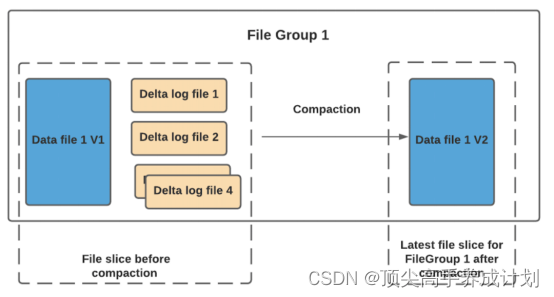
用户可以选择内联或异步模式运行压缩。Hudi也提供了不同的压缩策略供用户选择,最常用的一种是基于提交的数量。例如可以将压缩的最大增量日志配置为 4。这意味着在进行 4 次增量写入后,将对数据文件进行压缩并创建更新版本的数据文件。压缩完成后,读取端只需要读取最新的数据文件,而不必关心旧版本文件。
MOR表的写入行为,依据 index 的不同会有细微的差别:
- 对于 BloomFilter 这种无法对 log file 生成 index 的索引方案,对于 INSERT 消息仍然会写 base file (parquet format),只有 UPDATE 消息会 append log 文件(因为 base file 已经记录了该 UPDATE 消息的 FileGroup ID)。
对于可以对 log file 生成 index 的索引方案,例如 Flink writer 中基于 state 的索引,每次写入都是 log format,并且会不断追加和 roll over。
3****)COW与MOR的对比
CopyOnWrite
MergeOnRead
数据延迟
高
低
查询延迟
低
高
Update(I/O) 更新成本
高(重写整个Parquet文件)
低(追加到增量日志)
Parquet文件大小
低(更新成本I/O高)
较大(低更新成本)
写放大
大
低(取决于压缩策略)
查询类型(Query Types)
Hudi支持如下三种查询类型:
1)Snapshot Queries
快照查询,可以查询指定commit/delta commit即时操作后表的最新快照。
在读时合并(MOR)表的情况下,它通过即时合并最新文件片的基本文件和增量文件来提供近实时表(几分钟)。
对于写时复制(COW),它可以替代现有的parquet表(或相同基本文件类型的表),同时提供upsert/delete和其他写入方面的功能,可以理解为查询最新版本的Parquet数据文件。
下图是COW的快照查询:
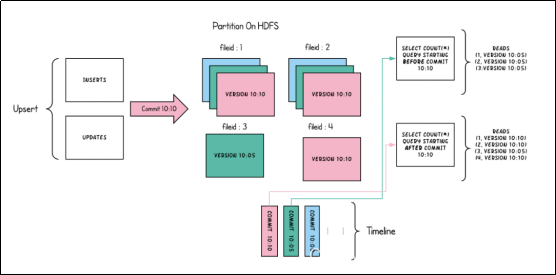
2)****Incremental Queries
增量查询,可以查询给定commit/delta commit即时操作以来新写入的数据。有效的提供变更流来启用增量数据管道。
3)Read Optimized Queries
读优化查询,可查看给定的commit/compact即时操作的表的最新快照。仅将最新文件片的基本/列文件暴露给查询,并保证与非Hudi表相同的列查询性能。
下图是MOR表的快照查询与读优化查询的对比:
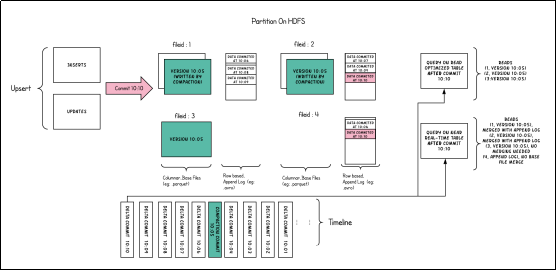
Read Optimized Queries是对Merge On Read表类型快照查询的优化。
Snapshot
Read Optimized
数据延迟
低
高
查询延迟
高(合并列式基础文件+行式增量日志文件)
低(原始列式基础文件)
4)不同表支持的查询类型

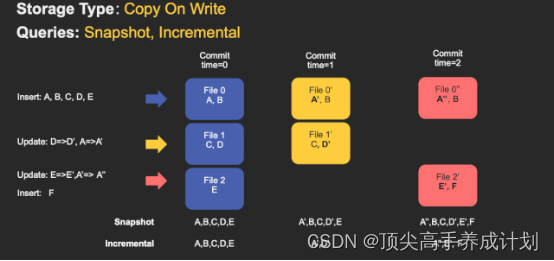
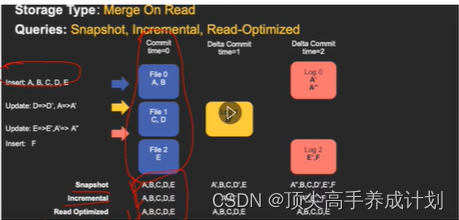
数据写
(1)UPSERT:默认行为,数据先通过 index 打标(INSERT/UPDATE),有一些启发式算法决定消息的组织以优化文件的大小 => CDC 导入
(2)INSERT:跳过 index,写入效率更高 => Log Deduplication
(3)BULK_INSERT:写排序,对大数据量的 Hudi 表初始化友好,对文件大小的限制 best effort(写 HFile)
写流程(UPSERT)
1)Copy On Write
(1)先对 records 按照 record key 去重
(2)首先对这批数据创建索引 (HoodieKey => HoodieRecordLocation);通过索引区分哪些 records 是 update,哪些 records 是 insert(key 第一次写入)
(3)对于 update 消息,会直接找到对应 key 所在的最新 FileSlice 的 base 文件,并做 merge 后写新的 base file (新的 FileSlice)
(4)对于 insert 消息,会扫描当前 partition 的所有 SmallFile(小于一定大小的 base file),然后 merge 写新的 FileSlice;如果没有 SmallFile,直接写新的 FileGroup + FileSlice
2)Merge On Read
(1)先对 records 按照 record key 去重(可选)
(2)首先对这批数据创建索引 (HoodieKey => HoodieRecordLocation);通过索引区分哪些 records 是 update,哪些 records 是 insert(key 第一次写入)
(3)如果是 insert 消息,如果 log file 不可建索引(默认),会尝试 merge 分区内最小的 base file (不包含 log file 的 FileSlice),生成新的 FileSlice;如果没有 base file 就新写一个 FileGroup + FileSlice + base file;如果 log file 可建索引,尝试 append 小的 log file,如果没有就新写一个 FileGroup + FileSlice + base file
(4)如果是 update 消息,写对应的 file group + file slice,直接 append 最新的 log file(如果碰巧是当前最小的小文件,会 merge base file,生成新的 file slice)
(5)log file 大小达到阈值会 roll over 一个新的
写流程(INSERT)
1)Copy On Write
(1)先对 records 按照 record key 去重(可选)
(2)不会创建 Index
(3)如果有小的 base file 文件,merge base file,生成新的 FileSlice + base file,否则直接写新的 FileSlice + base file
2)Merge On Read
(1)先对 records 按照 record key 去重(可选)
(2)不会创建 Index
(3)如果 log file 可索引,并且有小的 FileSlice,尝试追加或写最新的 log file;如果 log file 不可索引,写一个新的 FileSlice + base file
写流程(INSERT OVERWRITE)
在同一分区中创建新的文件组集。现有的文件组被标记为 "删除"。根据新记录的数量创建新的文件组
1)COW
在插入分区之前
插入相同数量的记录覆盖
插入覆盖更多的记录
插入重写1条记录
分区包含
file1-t0.parquet,file2-t0.parquet。
分区将添加file3-t1.parquet,file4-t1.parquet。file1, file2在t1后的元数据中被标记为无效。
分区将添加
file3-t1.parquet,
file4-t1.parquet,
file5-t1.parquet,
...,
fileN-t1.parquet。
file1, file2在t1后的元数据中被标记为无效
分区将添加file3-t1.parquet。file1, file2在t1后的元数据中被标记为无效。
2)MOR
在插入分区之前
插入相同数量的记录覆盖
插入覆盖更多的记录
插入重写1条记录
分区包含
file1-t0.parquet,
file2-t0.parquet。
.file1-t00.log
file3-t1.parquet,
file4-t1.parquet。
file1, file2在t1后的元数据中被标记为无效。
file3-t1.parquet,
file4-t1.parquet
...
fileN-t1.parquet
file1, file2在t1后的元数据中被标记为无效
分区将添加file3-t1.parquet。file1, file2在t1后的元数据中被标记为无效。
3)优点
(1)COW和MOR在执行方面非常相似。不干扰MOR的compaction。
(2)减少parquet文件大小。
(3)不需要更新关键路径中的外部索引。索引实现可以检查文件组是否无效(类似于在HBaseIndex中检查commit是否无效的方式)。
(4)可以扩展清理策略,在一定的时间窗口后删除旧文件组。
4****)缺点
(1)需要转发以前提交的元数据。
- 在t1,比如file1被标记为无效,我们在t1.commit中存储 "invalidFiles=file1"(或者在MOR中存储deltacommit)
- 在t2,比如file2也被标记为无效。我们转发之前的文件,并在t2.commit中标记 "invalidFiles=file1, file2"(或MOR的deltacommit)
(2)忽略磁盘中存在的parquet文件也是Hudi的一个新行为, 可能容易出错,我们必须认识到新的行为,并更新文件系统的所有视图来忽略它们。这一点可能会在实现其他功能时造成问题。
Key 生成策略
用来生成 HoodieKey(record key + partition path),目前支持以下策略:
- 支持多个字段组合 record keys
- 支持多个字段组合的 parition path (可定制时间格式,Hive style path name)
- 非分区表
删除策略
1)逻辑删:将 value 字段全部标记为 null
2)物理删:
(1)通过 OPERATION_OPT_KEY 删除所有的输入记录
(2)配置 PAYLOAD_CLASS_OPT_KEY = org.apache.hudi.EmptyHoodieRecordPayload 删除所有的输入记录
(3)在输入记录添加字段:_hoodie_is_deleted
总结
通过对写流程的梳理可以了解到 Apache Hudi 相对于其他数据湖方案的核心优势:
(1)写入过程充分优化了文件存储的小文件问题,Copy On Write 写会一直将一个 bucket (FileGroup)的 base 文件写到设定的阈值大小才会划分新的 bucket;Merge On Read 写在同一个 bucket 中,log file 也是一直 append 直到大小超过设定的阈值 roll over。
(2)对 UPDATE 和 DELETE 的支持非常高效,一条 record 的整个生命周期操作都发生在同一个 bucket,不仅减少小文件数量,也提升了数据读取的效率(不必要的 join 和 merge)。
数据读
Snapshot读
读取所有 partiiton 下每个 FileGroup 最新的 FileSlice 中的文件,Copy On Write 表读 parquet 文件,Merge On Read 表读 parquet + log 文件
Incremantal读
当前的 Spark data source 可以指定消费的起始和结束 commit 时间,读取 commit 增量的数据集。但是内部的实现不够高效:拉取每个 commit 的全部目标文件再按照系统字段 hoodie_commit_time apply 过滤条件。
Streaming读
0.8.0 版本的 HUDI Flink writer 支持实时的增量订阅,可用于同步 CDC 数据,日常的数据同步 ETL pipeline。Flink 的 streaming 读做到了真正的流式读取,source 定期监控新增的改动文件,将读取任务下派给读 task。
Compaction
(1)没有 base file:走 copy on write insert 流程,直接 merge 所有的 log file 并写 base file
(2)有 base file:走 copy on write upsert 流程,先读 log file 建 index,再读 base file,最后读 log file 写新的 base file
Flink 和 Spark streaming 的 writer 都可以 apply 异步的 compaction 策略,按照间隔 commits 数或者时间来触发 compaction 任务,在独立的 pipeline 中执行。
集成框架
集成 Spark
前期准备
Hudi支持的Spark版本
H****udi
S****upported Spark 3 version
0****.12.****x
3****.3.x,3.2.x,3.1.****x
0.11.x
3.2.x(default build, Spark bundle only),3.1.x
0****.10.****x
3.1.x(default build), 3.0.x
0.7.0-0.9.0
3.0.x
0.6.0 and prior
Not supported
下载Spark安装包,解压
wget https://archive.apache.org/dist/spark/spark-3.2.2/spark-3.2.2-bin-hadoop3.2.tgz
tar -zxvf spark-3.2.2-bin-hadoop3.2.tgz -C /opt/module/
mv /opt/module/spark-3.2.2-bin-hadoop3.2 /opt/module/spark-3.2.2
或者(如果机器在远程)
scp -P 22 ./hudi-spark3.2-bundle_2.12-0.12.0.jar bigdata@ip:/home/bigdata/module/hive-spark/hudi-spark/jars
配置环境变量
sudo vim /etc/profile.d/my_env.sh
export SPARK_HOME=/opt/module/spark-3.2.2
export PATH=$PATH:$SPARK_HOME/bin
source /etc/profile.d/my_env.sh
拷贝编译好的包到spark的jars目录
cp /opt/software/hudi-0.12.0/packaging/hudi-spark-bundle/target/hudi-spark3.2-bundle_2.12-0.12.0.jar /opt/module/spark-3.2.2/jars
spark-shell 方式
启动 spark**-**shell
启动命令
#针对Spark 3.2
spark-shell \
--conf 'spark.serializer=org.apache.spark.serializer.KryoSerializer' \
--conf 'spark.sql.catalog.spark_catalog=org.apache.spark.sql.hudi.catalog.HoodieCatalog' \
--conf 'spark.sql.extensions=org.apache.spark.sql.hudi.HoodieSparkSessionExtension'
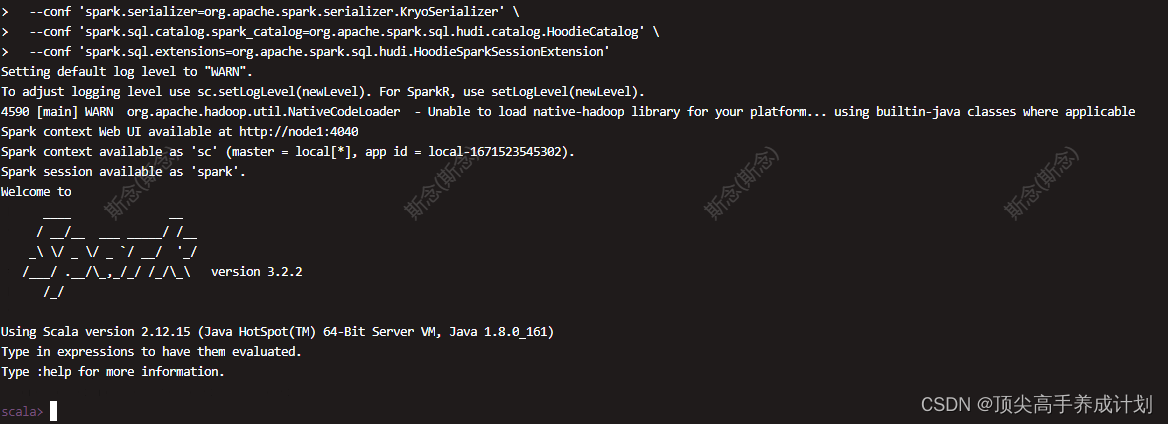
设置表名,基本路径和数据生成器
import org.apache.hudi.QuickstartUtils._
import scala.collection.JavaConversions._
import org.apache.spark.sql.SaveMode._
import org.apache.hudi.DataSourceReadOptions._
import org.apache.hudi.DataSourceWriteOptions._
import org.apache.hudi.config.HoodieWriteConfig._
val tableName = "hudi_trips_cow"
val basePath = "file:///tmp/hudi_trips_cow"
val dataGen = new DataGenerator
不需要单独的建表。如果表不存在,第一批写表将创建该表。
插入数据
新增数据,生成一些数据,将其加载到DataFrame中,然后将DataFrame写入Hudi表。
val inserts = convertToStringList(dataGen.generateInserts(10))
val df = spark.read.json(spark.sparkContext.parallelize(inserts, 2))
df.write.format("hudi").
options(getQuickstartWriteConfigs).
option(PRECOMBINE_FIELD_OPT_KEY, "ts").
option(RECORDKEY_FIELD_OPT_KEY, "uuid").
option(PARTITIONPATH_FIELD_OPT_KEY, "partitionpath").
option(TABLE_NAME, tableName).
mode(Overwrite).
save(basePath)
val inserts = convertToStringList(dataGen.generateInserts(10))
val df = spark.read.json(spark.sparkContext.parallelize(inserts, 2))
df.write.format("hudi").
options(getQuickstartWriteConfigs).
#这个表示当Key相同的时候用时间最大的替换之前的久的值
option(PRECOMBINE_FIELD_OPT_KEY, "ts").
#这个表示生成数据的key
option(RECORDKEY_FIELD_OPT_KEY, "uuid").
#表示分区的字段
option(PARTITIONPATH_FIELD_OPT_KEY, "partitionpath").
option(TABLE_NAME, tableName).
#文件写入的方式
mode(Overwrite).
save(basePath)
Mode(overwrite)将覆盖重新创建表(如果已存在)。可以检查/tmp/hudi_trps_cow 路径下是否有数据生成。
cd /tmp/hudi_trips_cow/
ls


数据文件的命名规则,源码如下:

查询数据
转换成DF
val tripsSnapshotDF = spark.
read.
format("hudi").
load(basePath)
tripsSnapshotDF.createOrReplaceTempView("hudi_trips_snapshot")
注意:该表有三级分区(区域/国家/城市),在0.9.0版本以前的hudi,在load中的路径需要按照分区目录拼接"",如:load(basePath + "////*"),当前版本不需要。
查询
spark.sql("select fare, begin_lon, begin_lat, ts from hudi_trips_snapshot where fare > 20.0").show()
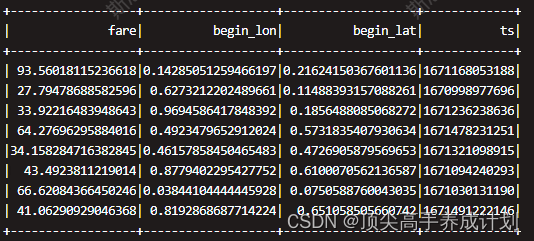
spark.sql("select _hoodie_commit_time, _hoodie_record_key, _hoodie_partition_path, rider, driver, fare from hudi_trips_snapshot").show()
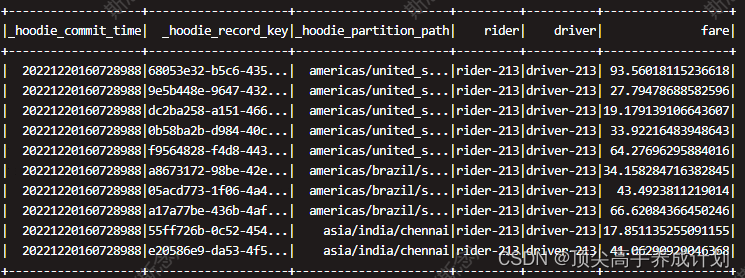
更新数据
类似于插入新数据,使用数据生成器生成新数据对历史数据进行更新。将数据加载到DataFrame中并将DataFrame写入Hudi表中。
val updates = convertToStringList(dataGen.generateUpdates(10))
val df = spark.read.json(spark.sparkContext.parallelize(updates, 2))
df.write.format("hudi").
options(getQuickstartWriteConfigs).
option(PRECOMBINE_FIELD_OPT_KEY, "ts").
option(RECORDKEY_FIELD_OPT_KEY, "uuid").
option(PARTITIONPATH_FIELD_OPT_KEY, "partitionpath").
option(TABLE_NAME, tableName).
mode(Append).
save(basePath)
注意:保存模式现在是Append。通常,除非是第一次创建表,否则请始终使用追加模式。现在再次查询数据将显示更新的行程数据。每个写操作都会生成一个用时间戳表示的新提交。查找以前提交中相同的_hoodie_record_keys在该表的_hoodie_commit_time、rider、driver字段中的变化。
查询更新后的数据,要重新加载该hudi表:
val tripsSnapshotDF1 = spark.
read.
format("hudi").
load(basePath)
tripsSnapshotDF1.createOrReplaceTempView("hudi_trips_snapshot")
spark.sql("select _hoodie_commit_time, _hoodie_record_key, _hoodie_partition_path, rider, driver, fare from hudi_trips_snapshot").show()
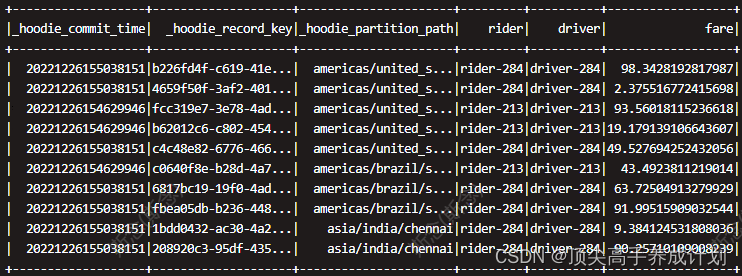
上图可以看到,如果生成的key相同,那么时间戳大的就会覆盖旧的数据。对应的修改文件的目录下也会生成一个对应时间搓的新的文件。
 时间旅行查询
时间旅行查询
spark.read.
format("hudi").
option("as.of.instant", "20210728141108100").
load(basePath)
spark.read.
format("hudi").
option("as.of.instant", "2021-07-28 14:11:08.200").
load(basePath)
// 表示 "as.of.instant = 2021-07-28 00:00:00"
spark.read.
format("hudi").
option("as.of.instant", "2021-07-28").
load(basePath)
重新创建一个临时表查询(这里时间旅行没有玩成功,后面复习补充下)
val tripsSnapshotDF3 = spark.
read.
format("hudi").
load(basePath)
tripsSnapshotDF3.createOrReplaceTempView("hudi_trips_snapshot")
spark.sql("select _hoodie_commit_time, _hoodie_record_key, _hoodie_partition_path, rider, driver, fare from hudi_trips_snapshot").show()
增量查询
Hudi还提供了增量查询的方式,可以获取从给定提交时间戳以来更改的数据流。需要指定增量查询的beginTime,选择性指定endTime。如果我们希望在给定提交之后进行所有更改,则不需要指定endTime(这是常见的情况)。
重新加载数据
spark.
read.
format("hudi").
load(basePath).
createOrReplaceTempView("hudi_trips_snapshot")
获取指定beginTime
val commits = spark.sql("select distinct(_hoodie_commit_time) as commitTime from hudi_trips_snapshot order by commitTime").map(k => k.getString(0)).take(50)
val beginTime = commits(commits.length - 2)
**创建增量表 **
val tripsIncrementalDF = spark.read.format("hudi").
option(QUERY_TYPE_OPT_KEY, QUERY_TYPE_INCREMENTAL_OPT_VAL).
option(BEGIN_INSTANTTIME_OPT_KEY, beginTime).
load(basePath)
tripsIncrementalDF.createOrReplaceTempView("hudi_trips_incremental")
查询增量表
spark.sql("select `_hoodie_commit_time`, fare, begin_lon, begin_lat, ts from hudi_trips_incremental").show()

这里要注意的是指定的时间点不包括,就是一个>不是>=的含义。
删除数据
根据传入的HoodieKeys来删除(uuid + partitionpath),只有append模式,才支持删除功能。
获取总行数
spark.sql("select uuid, partitionpath from hudi_trips_snapshot").count()
spark.sql("select uuid, partitionpath from hudi_trips_snapshot").show()
取其中2条用来删除
val ds = spark.sql("select uuid, partitionpath from hudi_trips_snapshot").limit(2)
将待删除的2条数据构建DF
val deletes = dataGen.generateDeletes(ds.collectAsList())
val df = spark.read.json(spark.sparkContext.parallelize(deletes, 2))
执行删除
df.write.format("hudi").
options(getQuickstartWriteConfigs).
option(OPERATION_OPT_KEY,"delete").
option(PRECOMBINE_FIELD_OPT_KEY, "ts").
option(RECORDKEY_FIELD_OPT_KEY, "uuid").
option(PARTITIONPATH_FIELD_OPT_KEY, "partitionpath").
option(TABLE_NAME, tableName).
mode(Append).
save(basePath)
统计删除数据后的行数,验证删除是否成功
val roAfterDeleteViewDF = spark.
read.
format("hudi").
load(basePath)
roAfterDeleteViewDF.registerTempTable("hudi_trips_snapshot")
// 返回的总行数应该比原来少2行
spark.sql("select uuid, partitionpath from hudi_trips_snapshot").count()
覆盖数据
对于表或分区来说,如果大部分记录在每个周期都发生变化,那么做upsert或merge的效率就很低。我们希望类似hive的 "insert overwrite "操作,以忽略现有数据,只用提供的新数据创建一个提交。
也可以用于某些操作任务,如修复指定的问题分区。我们可以用源文件中的记录对该分区进行'插入覆盖'。对于某些数据源来说,这比还原和重放要快得多。
Insert overwrite操作可能比批量ETL作业的upsert更快,批量ETL作业是每一批次都要重新计算整个目标分区(包括索引、预组合和其他重分区步骤)。
查看当前表的key
spark.
read.format("hudi").
load(basePath).
select("uuid","partitionpath").
sort("partitionpath","uuid").
show(100, false)
生成一些新的行程数据
val inserts = convertToStringList(dataGen.generateInserts(10))
val df = spark.
read.json(spark.sparkContext.parallelize(inserts, 2)).
filter("partitionpath = 'americas/united_states/san_francisco'")
覆盖指定分区
df.write.format("hudi").
options(getQuickstartWriteConfigs).
option(OPERATION.key(),"insert_overwrite").
option(PRECOMBINE_FIELD.key(), "ts").
option(RECORDKEY_FIELD.key(), "uuid").
option(PARTITIONPATH_FIELD.key(), "partitionpath").
option(TBL_NAME.key(), tableName).
mode(Append).
save(basePath)
查询覆盖后的key,发生了变化
spark.
read.format("hudi").
load(basePath).
select("uuid","partitionpath").
sort("partitionpath","uuid").
show(100, false)
Spark SQL方式
创建表
启动Hive的Metastore
nohup hive --service metastore &
启动spark****-****sql
#针对Spark 3.2
spark-sql \
--conf 'spark.serializer=org.apache.spark.serializer.KryoSerializer' \
--conf 'spark.sql.catalog.spark_catalog=org.apache.spark.sql.hudi.catalog.HoodieCatalog' \
--conf 'spark.sql.extensions=org.apache.spark.sql.hudi.HoodieSparkSessionExtension'
如果没有配置hive环境变量,手动拷贝hive-site.xml到spark的conf下
建表参数
参数名
默认值
说明
primaryKey
uuid
表的主键名,多个字段用逗号分隔。
同 hoodie.datasource.write.recordkey.field
preCombineField
表的预合并字段。
同 hoodie.datasource.write.precombine.field
type
cow
创建的表类型:
type = 'cow'
type = 'mor'
同hoodie.datasource.write.table.type
创建非分区表
创建一个cow表,默认primaryKey 'uuid',不提供preCombineField
create table hudi_cow_nonpcf_tbl (
uuid int,
name string,
price double
) using hudi;
创建一个mor非分区表
create table hudi_mor_tbl (
id int,
name string,
price double,
ts bigint
) using hudi
tblproperties (
type = 'mor',
primaryKey = 'id',
preCombineField = 'ts'
);
创建分区表
创建一个cow分区外部表,指定primaryKey和preCombineField
create table hudi_cow_pt_tbl (
id bigint,
name string,
ts bigint,
dt string,
hh string
) using hudi
tblproperties (
type = 'cow',
primaryKey = 'id',
preCombineField = 'ts'
)
partitioned by (dt, hh)
location '/tmp/hudi/hudi_cow_pt_tbl';
在已有的hudi表上创建新表
不需要指定模式和非分区列(如果存在)之外的任何属性,Hudi可以自动识别模式和配置。
非分区表
create table hudi_existing_tbl0 using hudi
location 'file:///tmp/hudi/dataframe_hudi_nonpt_table';
分区表
create table hudi_existing_tbl1 using hudi
partitioned by (dt, hh)
location 'file:///tmp/hudi/dataframe_hudi_pt_table';
通过CTAS**** (Create Table As Select)****建表
为了提高向hudi表加载数据的性能,CTAS使用批量插入作为写操作。
通过CTAS创建cow非分区表,不指定preCombineField
create table hudi_ctas_cow_nonpcf_tbl
using hudi
tblproperties (primaryKey = 'id')
as
select 1 as id, 'a1' as name, 10 as price;
通过CTAS创建cow分区表,指定preCombineField
create table hudi_ctas_cow_pt_tbl
using hudi
tblproperties (type = 'cow', primaryKey = 'id', preCombineField = 'ts')
partitioned by (dt)
as
select 1 as id, 'a1' as name, 10 as price, 1000 as ts, '2021-12-01' as dt;
通过CTAS从其他表加载数据
# 创建内部表
create table parquet_mngd using parquet location 'file:///tmp/parquet_dataset/*.parquet';
# 通过CTAS加载数据
create table hudi_ctas_cow_pt_tbl2 using hudi location 'file:/tmp/hudi/hudi_tbl/' options (
type = 'cow',
primaryKey = 'id',
preCombineField = 'ts'
)
partitioned by (datestr) as select * from parquet_mngd;
插入数据
默认情况下,如果提供了preCombineKey,则insert into的写操作类型为upsert,否则使用insert。
向非分区表插入数据
insert into hudi_cow_nonpcf_tbl select 1, 'a1', 20;
insert into hudi_mor_tbl select 1, 'a1', 20, 1000;
向分区表动态分区插入数据
insert into hudi_cow_pt_tbl partition (dt, hh)
select 1 as id, 'a1' as name, 1000 as ts, '2021-12-09' as dt, '10' as hh;
向分区表静态分区插入数据
insert into hudi_cow_pt_tbl partition(dt = '2021-12-09', hh='11') select 2, 'a2', 1000;
使用bulk_insert****插入数据
hudi支持使用bulk_insert作为写操作的类型,只需要设置两个配置:
hoodie.sql.bulk.insert.enable和hoodie.sql.insert.mode。
-- 向指定preCombineKey的表插入数据,则写操作为upsert
insert into hudi_mor_tbl select 1, 'a1_1', 20, 1001;
select id, name, price, ts from hudi_mor_tbl;
1 a1_1 20.0 1001
-- 向指定preCombineKey的表插入数据,指定写操作为bulk_insert
set hoodie.sql.bulk.insert.enable=true;
set hoodie.sql.insert.mode=non-strict;
insert into hudi_mor_tbl select 1, 'a1_2', 20, 1002;
select id, name, price, ts from hudi_mor_tbl;
1 a1_1 20.0 1001
1 a1_2 20.0 1002
查询数据
select fare, begin_lon, begin_lat, ts from hudi_trips_snapshot where fare > 20.0
时间旅行查询
Hudi从0.9.0开始就支持时间旅行查询。Spark SQL方式要求Spark版本 3.2及以上。
-- 关闭前面开启的bulk_insert
set hoodie.sql.bulk.insert.enable=false;
create table hudi_cow_pt_tbl1 (
id bigint,
name string,
ts bigint,
dt string,
hh string
) using hudi
tblproperties (
type = 'cow',
primaryKey = 'id',
preCombineField = 'ts'
)
partitioned by (dt, hh)
location '/tmp/hudi/hudi_cow_pt_tbl1';
-- 插入一条id为1的数据
insert into hudi_cow_pt_tbl1 select 1, 'a0', 1000, '2021-12-09', '10';
select * from hudi_cow_pt_tbl1;
-- 修改id为1的数据
insert into hudi_cow_pt_tbl1 select 1, 'a1', 1001, '2021-12-09', '10';
select * from hudi_cow_pt_tbl1;
-- 基于第一次提交时间进行时间旅行
select * from hudi_cow_pt_tbl1 timestamp as of '20220307091628793' where id = 1;
-- 其他时间格式的时间旅行写法
select * from hudi_cow_pt_tbl1 timestamp as of '2022-03-07 09:16:28.100' where id = 1;
select * from hudi_cow_pt_tbl1 timestamp as of '2022-03-08' where id = 1;
更新数据
update
更新操作需要指定preCombineField。
UPDATE tableIdentifier SET column = EXPRESSION(,column = EXPRESSION) [ WHERE boolExpression]
执行更新
update hudi_mor_tbl set price = price * 2, ts = 1111 where id = 1;
update hudi_cow_pt_tbl1 set name = 'a1_1', ts = 1001 where id = 1;
-- update using non-PK field
update hudi_cow_pt_tbl1 set ts = 1111 where name = 'a1_1';
MergeInto
MERGE INTO tableIdentifier AS target_alias
USING (sub_query | tableIdentifier) AS source_alias
ON <merge_condition>
[ WHEN MATCHED [ AND <condition> ] THEN <matched_action> ]
[ WHEN MATCHED [ AND <condition> ] THEN <matched_action> ]
[ WHEN NOT MATCHED [ AND <condition> ] THEN <not_matched_action> ]
<merge_condition> =A equal bool condition
<matched_action> =
DELETE |
UPDATE SET * |
UPDATE SET column1 = expression1 [, column2 = expression2 ...]
<not_matched_action> =
INSERT * |
INSERT (column1 [, column2 ...]) VALUES (value1 [, value2 ...])
执行案例
-- 1、准备source表:非分区的hudi表,插入数据
create table merge_source (id int, name string, price double, ts bigint) using hudi
tblproperties (primaryKey = 'id', preCombineField = 'ts');
insert into merge_source values (1, "old_a1", 22.22, 2900), (2, "new_a2", 33.33, 2000), (3, "new_a3", 44.44, 2000);
merge into hudi_mor_tbl as target
using merge_source as source
on target.id = source.id
when matched then update set *
when not matched then insert *
;
-- 2、准备source表:分区的parquet表,插入数据
create table merge_source2 (id int, name string, flag string, dt string, hh string) using parquet;
insert into merge_source2 values (1, "new_a1", 'update', '2021-12-09', '10'), (2, "new_a2", 'delete', '2021-12-09', '11'), (3, "new_a3", 'insert', '2021-12-09', '12');
merge into hudi_cow_pt_tbl1 as target
using (
select id, name, '2000' as ts, flag, dt, hh from merge_source2
) source
on target.id = source.id
when matched and flag != 'delete' then
update set id = source.id, name = source.name, ts = source.ts, dt = source.dt, hh = source.hh
when matched and flag = 'delete' then delete
when not matched then
insert (id, name, ts, dt, hh) values(source.id, source.name, source.ts, source.dt, source.hh)
删除数据
语法
DELETE FROM tableIdentifier [ WHERE BOOL_EXPRESSION]
案例
delete from hudi_cow_nonpcf_tbl where uuid = 1;
delete from hudi_mor_tbl where id % 2 = 0;
-- 使用非主键字段删除
delete from hudi_cow_pt_tbl1 where name = 'a1_1';
覆盖数据
- 使用INSERT_OVERWRITE类型的写操作覆盖分区表
- 使用INSERT_OVERWRITE_TABLE类型的写操作插入覆盖非分区表或分区表(动态分区)
****insert overwrite ****非分区表
insert overwrite hudi_mor_tbl select 99, 'a99', 20.0, 900;
insert overwrite hudi_cow_nonpcf_tbl select 99, 'a99', 20.0;
*通过动态分区*****insert overwrite ****table到分区表
insert overwrite table hudi_cow_pt_tbl1 select 10, 'a10', 1100, '2021-12-09', '11';
*通过静态分区*****insert overwrite ****分区表
insert overwrite hudi_cow_pt_tbl1 partition(dt = '2021-12-09', hh='12') select 13, 'a13', 1100;
修改表结构(Alter Table)
语法
-- Alter table name
ALTER TABLE oldTableName RENAME TO newTableName
-- Alter table add columns
ALTER TABLE tableIdentifier ADD COLUMNS(colAndType (,colAndType)*)
-- Alter table column type
ALTER TABLE tableIdentifier CHANGE COLUMN colName colName colType
-- Alter table properties
ALTER TABLE tableIdentifier SET TBLPROPERTIES (key = 'value')
案例
--rename to:
ALTER TABLE hudi_cow_nonpcf_tbl RENAME TO hudi_cow_nonpcf_tbl2;
--add column:
ALTER TABLE hudi_cow_nonpcf_tbl2 add columns(remark string);
--change column:
ALTER TABLE hudi_cow_nonpcf_tbl2 change column uuid uuid int;
--set properties;
alter table hudi_cow_nonpcf_tbl2 set tblproperties (hoodie.keep.max.commits = '10');
修改分区
语法
-- Drop Partition
ALTER TABLE tableIdentifier DROP PARTITION ( partition_col_name = partition_col_val [ , ... ] )
-- Show Partitions
SHOW PARTITIONS tableIdentifier
案例
--show partition:
show partitions hudi_cow_pt_tbl1;
--drop partition:
alter table hudi_cow_pt_tbl1 drop partition (dt='2021-12-09', hh='10');
注意:show partition结果是基于文件系统表路径的。删除整个分区数据或直接删除某个分区目录并不精确。
存储过程(Procedures)
语法
--Call procedure by positional arguments
CALL system.procedure_name(arg_1, arg_2, ... arg_n)
--Call procedure by named arguments
CALL system.procedure_name(arg_name_2 => arg_2, arg_name_1 => arg_1, ... arg_name_n => arg_n)
案例
可用的存储过程:Procedures | Apache Hudi
--show commit's info
call show_commits(table => 'hudi_cow_pt_tbl1', limit => 10);
版权归原作者 顶尖高手养成计划 所有, 如有侵权,请联系我们删除。